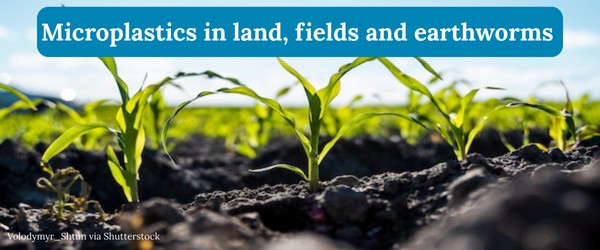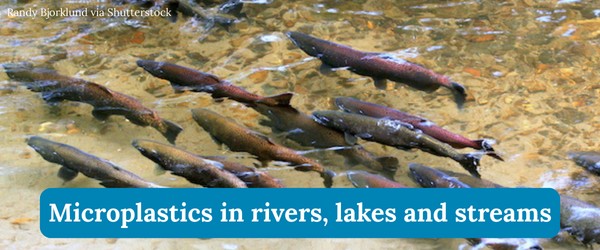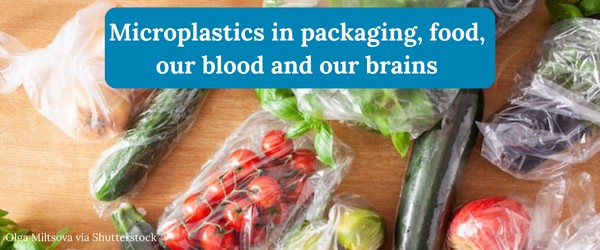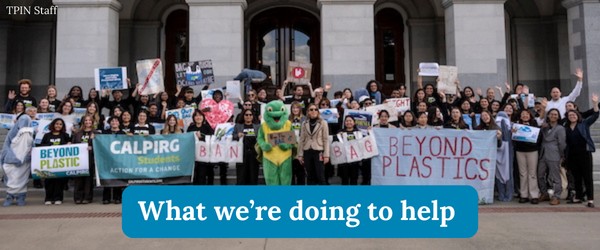
John,
Where do microplastics -- those tiny, often invisible fragments of plastic that are being found everywhere -- come from?1
How do they end up in our land, water and eventually, bodies?
And why does it matter for our health and environment?
Let's follow a few of the paths microplastics can travel and see what we can find out.

Our story may begin somewhere as simple as a kitchen sink.
There, tiny plastic fragments shed off and are rinsed down the drain as a plastic soda bottle is washed out. The water from the sink moves down the pipes to a water treatment center, with the near-microscopic fragments of plastic along for the ride.
From there the water travels along, until eventually this water, and maybe some of the microplastics it's carrying, is sprayed across the field of a nearby farm.
Once applied to the farmland, plastic particles may be worked into the topsoil by weather and equipment where growing crops may absorb it.2
Or maybe, a passing earthworm or other soil life mistakes some of plastic for organic matter and ingests it, passing it up the food chain to a local robin.
Regardless, microplastics can accumulate in ecosystems and soil, where they can persist at measurable, impactful levels, for years, even decades.3
Unless of course, they are washed away...

Soon, heavy rains fall on the fields.
The microplastic fragments may be washed from the soil into a roadside ditch, then a creek, then perhaps into a local river. From there plastic fragments can drift among algae and insect larvae until a small fish snaps up what they believe to be a little insect or a fish egg.
Later, a larger fish eats the smaller fish -- along with everything inside it.
Once inside a fish, plastic particles persist. They don't digest. They don't break down, they just continue to travel and move through the food chain, passing from organism to organism.3,4
That's until someone hauls the fish, and whatever plastic it may have ingested, onto the deck of a commercial fishing boat ...

Soon after, a person buys a contaminated fish, and whatever plastic it may contain, for dinner. From there, plastic particles may make one final jump, straight into someone's body.5,6
While evidence is still building about what microplastics may do to the human body, early findings have linked microplastic exposure to chronic inflammation, cancers, developmental issues and other severe health impacts.7
And fish aren't the only source of this pollution. Research suggests that even using plastic packaging as intended, like unscrewing bottle caps, peeling open film or opening bags may be shedding microplastics directly into our food and drinks.8

Microplastics are everywhere not because they are such effective travelers (which they are), but because we make and use so much plastic -- especially single-use plastic, which are about half of all plastics produced today.9
That's why PIRG, our national network and our supporters have been urging companies to reduce their plastic footprint and cut the amount of single-use plastic entering our environment.
Every piece of plastic avoided is a piece that never breaks into fragments and never ends up in a field, a river or a body.
Together, we can keep plastic off our plates, and out of our air, water, wildlife and soil.
Thank you for doing your part to keep plastic out of our environment and our bodies,
Faye Park
President
P.S. If you'd like to advance our work to reduce plastic waste and the microplastics that are flooding our environment, then consider supporting us with a donation today.
1. Grace Vickers, Celeste Meiffren-Swango, "Studies show how microplastics from packaging get into our food," PIRG, July 21, 2025.
2. Sara Hashemi, "Microplastics Are Making Photosynthesis Harder for Plants--and That Could Slash Crop Yields, Study Suggests," Smithsonian Magazine, March 13, 2025.
3. "Impacts of Plastic Pollution," Environmental Protection Agency, May 15, 2025.
4. "Ingestion," Marine Debris Program NOAA, February 7, 2023.
5. Caroline Johnson, "New study finds microplastics in commonly eaten seafood," Environment America Research and Policy Center, January 17, 2025.
6. Lisa Frank, Kelly Leviker, "What happens to fish (and humans) when fish eat plastic?," Environment America Research and Policy Center, March 4, 2025.
7. Grace Vickers, Celeste Meiffren-Swango, "Studies show how microplastics from packaging get into our food," PIRG, July 21, 2025.
8. Grace Vickers, Celeste Meiffren-Swango, "Studies show how microplastics from packaging get into our food," PIRG, July 21, 2025.
9. "Reusing 10% Will Stop Almost Half of Plastic Waste From Entering the Ocean," World Economic Forum, July 22 2021.
If you're interested, this article contains more examples of the many paths microplastics can take through our environment: Phoebe Weston, Tess McClure, "The life of plastic," The Guardian, July 28, 2025.
Your donation will power our dedicated staff of organizers, policy experts and attorneys who drive all of our campaigns in the public interest, from banning toxic pesticides and moving us beyond plastic, to saving our antibiotics and being your consumer watchdog, to protecting our environment and our democracy. None of our work would be possible without the support of people just like you.
Join us on Facebook | Follow us on Twitter
U.S. PIRG, Main Office: 1543 Wazee St., Suite 460, Denver, CO 80202, (303) 801-0582
Federal Advocacy Office: 600 Pennsylvania Ave. SE, 4th Fl., Washington, DC 20003, (202) 546-9707
Member Questions or Requests: 1-800-838-6554.

If you want us to stop sending you email then follow this link -- unsubscribe.